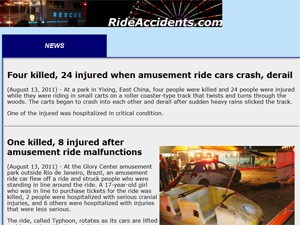The “that can’t really be happening” video of the tragic Saturday-night stage collapse in Indiana – which killed five people and sent dozens more to hospital – still is prominent on the airwaves today as officials investigate the deadly combination of weather and possible defects in the rigging of the temporary stage.
It’s going to be a high-visibility story for some time to come, and one you might want to localize with a look at the inspection and regulation of public entertainment venues in your region.
For starters, we appear to be amid peak county-fair season, according to this Countyfairgrounds.net calendar site, which is searchable by state (when working). It also lists horse shows, rodeos and other indoor/outdoor events likely to feature grandstands. Other sites with listings include festivals.com and festivalsandevents.com. Fairgrounds tend to be regulated by the agriculture department in most states or counties, as far as I can tell. You may have to do a bit of legwork to track down all of the venues and operators in your state. I found a good list for Michigan not on the ag department site but on the state tourism site, so keep that in mind when searching.
Here’s a starter list of Renaissance Faire events, too; I’m not familiar with what structural elements are involved in one but worth checking to see which entities, if any, regulate them, especially those on private property.
Then there are the fixed-site amusement parks and water parks, along with traveling carnivals and miscellaneous venues such as go-kart racing tracks and paintball mazes. A clip-and-save graphic of how each sort of venue is regulated and how many accidents or injuries occurred at each the past several years (worker and patron) would be a substantive and useful report for your readers. PDFs of actual accident reports online and a look at the budget (and any cuts) of safety inspectors, etc., would make a riveting package in light of recent headlines.

Injuries and deaths at amusement venues are more common than you may think; see the stats at RideAccidents.com, a privately operated website that claims to be non-biased and reports park and carnival accidents based on public records. (The site is searchable by state and records go back several years.) Fatalities in 2011 alone range from Ferris-wheel falls to worker electrocution; oddly, inflatable rides/attractions seem particularly fraught with peril. (Might be worth checking on liability/safety issues for the small businesses that rent those portable ones for home parties.)
Determining regulatory authority may be difficult. According to several sources, including this Safeparks.org website, it’s a state-by-state mishmash with some states having zero regulatory authority and others letting third-party vendors or insurance companies do much of the oversight. An eye-opener for many readers, no doubt. This PDF file from the Consumer Product Safety Commission indicates the agency in each state that is nominally responsible for amusement-park safety.
Google “amusement park injury attorney” and you might be surprised at what you turn up! There seems to be an entire cottage industry out there based on suing amusement parks; some firms even specialize in specific companies such as Disney. That’s a basis for a whole different sort of business story. Many of these firms seem to run blogs on their websites; might be good for interesting (if somewhat biased) background material and access to actual plaintiffs. Try insurance companies, too.
The daily e-mail “Extra, extra!” newsletter from the Amusement Today industry magazine is extremely timely and helpful. I strongly suggest signing up via an e-mail to this gentleman: john@whrobinsoninc.com. Industry coverage ranges from the largest publicly traded venues to Halloween haunted houses and other seasonal attractions. (Speaking of which: who regulates safety at those charity-built or otherwise semi-homemade haunted houses that will abound come late September? Another one for your tickler file…)










